David Allen's Blog, page 38
October 29, 2018
The 2019 GTD® Organizer is now available
The 2019 GTD Organizer is an elegant, functional, and complete system, built on the GTD principles. We created it to give people a way to get people up and running with a tool that is completely aligned with GTD.
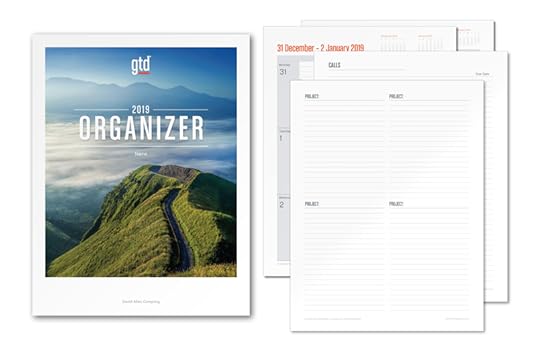
How to Use It
The GTD Organizer comes as an editable PDF download that can be used in several effective ways:
As a PDF file that you type into and store electronically
As a PDF file that you type into and then print as your paper organizer
As paper forms that you can print and then write on as your paper organizer
What’s Included in the GTD Organizer
The complete GTD Organizer includes:
Notes/In
2019 Calendar, in week-at-a-glance format (Mon, Tue, Wed on one page; Thu, Fri, Sat, Sun on the next page)
Next Actions Lists
Agendas Lists
Projects Lists
Project Support Pages
Someday/Maybe Lists
Focus & Direction Pages
Reference Pages
Contacts Pages
Extra Pages
Available in letter or Junior size.
Don’t need list pages or already use the Organizer? We also offer a Calendar-only version.
The post The 2019 GTD® Organizer is now available appeared first on Getting Things Done®.
October 26, 2018
Getting things off your mind
Even very important things can be on cruise control and not on your mind. If your attention is being grabbed, then there’s almost an inverse relationship there. The degree to which your attention is being grabbed is the degree to which you are not free to place your attention where and how you want to. So, if nothing else, it’s just a pure practical idea that, if you can get rid of the demons that are grabbing hold of your brain and shaking it around—whether that’s buy cat food or reconsidering your career—then it will give you a lot more freedom to be thinking about those things in more creative ways or not have to think about them at all. –David Allen

Have you done a Mind Sweep lately? It’s a great way to see what’s grabbing your attention. We offer live Guided Mind Sweep webinars on GTD Connect and you can also listen to the free podcast with David Allen through the GTD public podcast.
The post Getting things off your mind appeared first on Getting Things Done®.
October 22, 2018
Aliman’s GTD Story
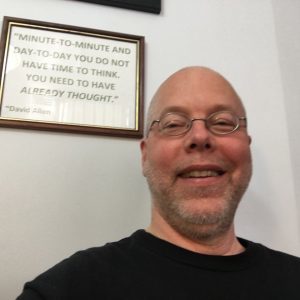 Tell us a little about yourself:
Tell us a little about yourself:
My name is Aliman Sears from the Island of Oahu, Honolulu, Hawaii (Kailua side). My primary work is chief operating officer and co-founder of a nonprofit psychiatric social work agency. I am also adjunct professor of philosophy at Chaminade University, Honolulu.
How did you hear about GTD?
In 2016 during meditation I “directly received” that I could get myself organized and relieve stress if I captured everything, decided what needed to be done with it (if anything), then wrote it down on my “To Do” list. Note I had never heard of David Allen nor GTD. I started doing these three steps, and it radically changed the way I worked in a wonderful way. But I didn’t have the benefit of the whole system, so I was still struggling with “not enough time.” Fast forward to March 2018 at the end of a meeting, when one of our consultants said, “David Allen, who has a system called GTD, says that at the end of a meeting you should have clear actions to take, and you should define in a very concrete way the next, actual, physical action that you need to do to move the project forward.” I just stared at him—I was stunned. My inner/intuitive fireworks blasted into the sky. Before everyone was even out of my office, I jumped online and ordered FIVE copies of David’s book—sight unseen! I somehow knew this was it! The books arrived about a week later, and by page four I was amazed and knew I had finally found something to help put things in perspective. I gave copies to my key staff, and we’re now in process of implementing GTD company wide.
How long have you been practicing GTD now?
I discovered GTD in March 2018, and started implementing it in April 2018. It took one month to get through the “Capture” stage as I had about five stacks of “stuff,” each about five feet tall! That’s why the next thing is so amazing:
How has GTD made a difference in your work and life?
A) My office is pristine—only R.E.D.S and nothing else—it’s been that way for six months. This one fact is amazing! B) My staff is chagrined because they always said, “Don’t worry, Aliman will forget about X and Y.” And they were right. But since GTD I don’t forget anything anymore. C) After a few months of GTD, I stopped waking up at 2:00am wondering and worrying. D) I get 100 emails a day and had 1,000 in my inbox; now my inbox is zero at least once per day and nothing “slips through the cracks” any longer. E) I FINALLY have a handle on everything I’m committed to; I know exactly where all my projects are or are not, so I no longer have a gnawing sense in the background that worries me about whether or not something is done.
What areas of GTD are you doing really well (or at least better than you used to)?
Email inbox to zero. Also, I now have in my office a manila folder system for all my projects that display on a long shelf behind me (about 120 projects) so everything is at my fingertips. The file folders are numbered and the numbers correspond to control numbers on my Projects Lists and Next Action Lists.
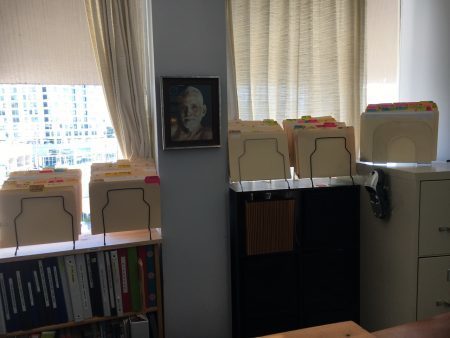
What areas of GTD would you like to get even better at doing?
Weekly Reviews! Also, I need to settle on a paper system or electronic. I sort of do a mixture now and I’m not sure that’s going to work well in the long run. I took the Focus Survey and got some coaching from Frank Sopper, which was tremendously helpful. Next I’ll do a little coaching with a certified GTD coach (next week) and really look forward to bringing my practice to the next level.
What is one piece of advice you would give to someone just starting out with GTD?
If you’re just starting out—PLEASE—just read David’s book (2015) and implement it as he recommends. I can’t tell you how much pain I went through trying to tweak the system in a way that seemed it would be easier for me. That backfired! I went through about SIX ITERATIONS of my system, and each time it got closer to David’s, until when it was finally settled and working well, and to my chagrin, I saw it was exactly as David had set out in the book! Now, months later, I have tweaked it a bit to fit me better. But in the beginning save yourself a lot of time and resources and implement it as David suggests—there’s a reason he wrote the book and set it out that way!
The post Aliman’s GTD Story appeared first on Getting Things Done®.
October 10, 2018
Getting to inbox zero
Question:
According to David Allen, we should get clear daily. Does this mean daily inbox zero for email? I feel like if I got to inbox zero daily, especially with email, that’s all I would do.

Coach Kelly Forrister:
Great question. It’s really a balance of every day of the 3 types of work, as described in GTD’s Threefold Nature of Work model:
Defining work (getting clear)
Predefined work (things already scheduled for you to do that day)
Unplanned work (All of the things that show up for you to handle each day)
While inbox zero every day is a great goal, you don’t want to sacrifice predefined work or unplanned to only do defining. Some people have such high volume too that getting in to zero each day just isn’t realistic. And those less than two minute ones can chew your day away quickly. That said, most people, in my coaching experience, don’t spend nearly enough time on defining because they don’t consider it “real work.” And, they have so much backlog that it seems unattainable.
Defining is as much of your work as anything else. To figure out how much defining time is realistic for you, take the average number of emails you get a day and divide by 2. That will give you number of minutes required. For example, if you get 200 emails, you need 100 minutes to clarify those. For most people, it works out to about an hour or two a day just for dedicated processing (not in one sitting necessarily).
At the very least, your Weekly Reviews should drive everything to zero. And if that feels like too much to do in one sitting, do the Get Clear part of the Review one day and Get Current and Creative the next.
For more support on how to get to Inbox Zero, check out the webinars on GTD Connect and the free article on getting your inbox to zero.
The post Getting to inbox zero appeared first on Getting Things Done®.
September 28, 2018
Where should I start with GTD?
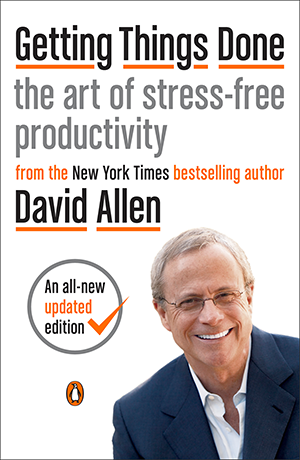 People worldwide are discovering the Getting Things Done® methodology; and often I’m asked, “Where should I start with GTD?!” They have either read the book, been to a course, heard about it on a podcast or from a friend; and they have sufficient inspiration or at least curiosity to test it out. But because there are multiple aspects and components of the GTD approach, they’re feeling a bit lost about how to engage, to begin with.
People worldwide are discovering the Getting Things Done® methodology; and often I’m asked, “Where should I start with GTD?!” They have either read the book, been to a course, heard about it on a podcast or from a friend; and they have sufficient inspiration or at least curiosity to test it out. But because there are multiple aspects and components of the GTD approach, they’re feeling a bit lost about how to engage, to begin with.
It’s also a question posed by people who have seriously “fallen off the wagon” in their GTD practices. They’ve tasted the delicious aspects of stress-free productivity the process provides, but things have slipped, and they’ve fallen back into the experience of unclarity and overwhelm. “How can I best get back on?!”
For anyone and everyone in either of the above categories, I have a very strict and specific procedure that must be followed, without exception. If followed, it’s a guarantee of success. If not, well… good luck.
Where, exactly, should you start?
(Hang on, this is going to be tough…)
Start anywhere.
Yes, anywhere. Any portion or component of the GTD approach, applied, will bring at least a bit more clarity, focus, and control for you—without exception. And very likely when any one thing is executed, it will create a reverberation effect and spread to other parts. It’s a holistic model—i.e. any piece can be worked, and it will add to the whole gestalt.
Capture what’s grabbing your attention. Simply decide the very next action on anything you need to be making progress on. Clean a closet. Allow yourself to fantasize where and how you’d like to be, five years from now. Any of those actions (or a hundred more) could prime your pump to engage in some next step.
That said, one cool starting point would be to go through Part 2 of the book Getting Things Done, which serves as a hands-on instruction manual, step-by-step, walking you through the implementation of GTD. Of course, you could hire a David Allen Academy certified coach who can do the same thing (virtually or in person), with the added impetus of having someone right with you, holding you to and through the process (think: personal trainer in your gym).
But if those are not options for you right now, I’ve listed below some typically great starting points. I’ve used each of them many times both for myself and for clients and friends. There’s no danger here—nothing about GTD is like running with scissors! It’s all good stuff.
Take your pick
Write down what’s on your mind. This is an obvious one, if you’re familiar with GTD at all. But for beginners and even sophisticated practitioners, it’s a recurring refrain: unload! Even if you take a mere three minutes and jot down the top-of-mind things rattling around in there, you’re doing great.
Clean a drawer. No kidding. It’s one of the best therapies in the world for getting back in your psychological driver’s seat. And, unless you just moved into a new place this morning, there is always a drawer to clean.
Get a piece of cool gear. A new notepad, a fountain pen or slick-writing ballpoint, some new app you saw someone using really productively, a shredder, a labeler, an executive-like in-tray, plastic folders or envelopes…whatever floats your boat that indicates better or more capturing or organizing. Good toys can be magical in this regard.
Tackle one pile. There’s likely at least one stack of stuff somewhere in your environment that you’ve gone somewhat numb to, but you know it contains things to be sorted and organized—trashed, filed, or curated for next actions or projects.
Delete one email folder. Surely there’s at least one that is outdated that you can dump.
Purge a filing drawer. Similar to, but a bit more rigorous than dealing with a pile, this can often make a big dent in getting your act more together. Everything in your drawers and filing containers belonged there at one time, but time itself changes the meaning of much of it. Crap self-generates, it doesn’t self-destruct.
Do a two-minute-action walk-around. Get up and walk around your office or home looking for anything that needs doing that you can use the two-minute rule for. Change the light bulb. Tighten that whatever with a screwdriver. Raise or lower a seat. Straighten that painting. Put those boots where they really belong.
Define and take the next action on one new cool thing to do. A vacation spot to explore, a creative pastime to start, a special event to put together.
Celebrate the easy wins
All of these (and many more) would be part of a full GTD implementation, in any case. And, if doing any of these kinds of activities starts to get your productivity juices flowing, it would be wise to channel that energy into some next level in your capturing, clarifying, organizing, reflecting, and engaging practices. We all need to make sure we’ve lowered the bar sufficiently to get going, on anything. Then we celebrate the easy wins and move forward to the bigger ones.
This essay appeared in David Allen’s Productive Living Newsletter. Subscribe for free here.
The post Where should I start with GTD? appeared first on Getting Things Done®.
September 27, 2018
Episode #44: GTD for Creative People
Musician Evan Taubenfeld and entertainment lawyer Danny Passman join David Allen and Coach Kelly Forrister in an inspiring conversation about GTD for creative people. Lots of wonderful nuggets in this episode about finding the creative spark within the structure of a GTD system.
Listen Now—GTD for Creative People
Subscribe or Download to GTD Podcasts
iTunes
Stitcher
Libsyn
Google Play Music
Spotify
SoundCloud
The post Episode #44: GTD for Creative People appeared first on Getting Things Done®.
September 26, 2018
GTD & Nirvana Setup Guide
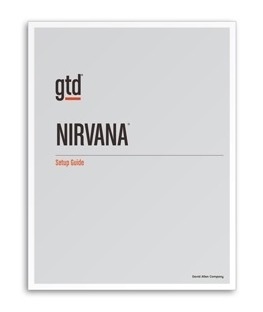 We’re excited to release a guide that many people have requested over the years–GTD & Nirvana. This elegant app, built with GTD in mind, is a great option for managing your lists.
We’re excited to release a guide that many people have requested over the years–GTD & Nirvana. This elegant app, built with GTD in mind, is a great option for managing your lists.
This new GTD & Nirvana Guide will show you how to:
– Understand the fundamental GTD best practices
– Optimally configure Nirvana in the way we have found works best for GTD
– Integrate your actionable email
– Create project, next actions, waiting for, and someday/maybe lists in Nirvana
– Manage useful reference lists
– Use tags effectively
… and much more
Available as a PDF download from the GTD Shop.
Not a Nirvana user? We also have GTD guides for many other popular tools we have found to work well for implementing GTD.
The post GTD & Nirvana Setup Guide appeared first on Getting Things Done®.
September 25, 2018
Doug’s GTD Story
Tell us a little about you and your work
My name is Doug Crane and I am a librarian by profession for over 22 years. I currently have the honor to serve as Director of the Palm Beach County Library System in southeast Florida where I oversee the major executive functions of a busy seventeen-branch public library system.

How did you hear about GTD?
Not surprisingly, I found it at the library as an audiobook version on CD! I was looking for a better way to stay organized and keep on top of my work, so the title caught my eye. As I listened to David Allen’s voice reading his book on my commute home, I connected with the material very quickly. At that point, I knew that GTD was for me.
How long have you been practicing GTD?
I started in 2011. I am one of those excited people who dove in head first and did a total implementation of the GTD process within the first month. One of the best support tools for the early years of practice was the 10 CD set of David Allen’s complete GTD two-day seminar. I pretty much listened to it on repeat in my car. Each time I listened, it took me deeper into the GTD process. I still dive into seminar from time to time for a refresher.
How has GTD made a difference in your work and life?
Within three years of implementing GTD, I promoted from a Branch Manager to Director of the entire library system. GTD provided me with a level of clarity and focus to my work that was not possible without it. The understanding on how to function effectively as an executive completely transformed my approach to knowledge work. The practice of capturing what has my attention and putting reminders into a trusted system for work and life is an essential skill in this busy age.
On a deeper professional level, I am exploring how productivity and efficiency practices intersect with the values and principles of librarianship. I recently wrote an article on the topic called “Efficient Librarianship: A New Path for the Profession” that was published in Public Libraries magazine, a major trade publication. I believe that GTD practices map on to the core principles of librarianship as my profession transforms to meet the needs of our members in the digital age.
What areas of GTD are you doing really well (or at least better than you used to)?
I have run with Inbox Zero (paper and electronic) for seven years. It was one of the first parts of GTD that I implemented and found to be a huge game changer. Processing the inbox every 24-48 is an easy win and huge stress reducer. I love it.
What areas of GTD would you like to get even better at doing?
Like most people, keeping an up-to-date project list is my Achilles Heel. I have tried several different approaches, but unfortunately found it easy to let the project list slide when I am busy. Of all the areas of GTD it is the one that I need to keep working on.
What is one piece of advice you would give to someone just starting out with GTD?
I have been sharing GTD and related productivity practices with my colleagues in Florida and across the country through book talks and seminars for many years. I love communicating this information and getting people hooked on the process. For those who are reluctant or skeptical, I challenge them to try out the Two Minute Rule. It is simple to implement and provides immediate positive feedback. For anyone starting out, it is an easy path to quick wins at work.
For more GTD stories like this, visit GTDConnect.com.
The post Doug’s GTD Story appeared first on Getting Things Done®.
September 19, 2018
What are the Best Apps for GTD?
 A question we often get from the GTD community is, “What are the best apps for GTD?” While we would love to give you a simple
A question we often get from the GTD community is, “What are the best apps for GTD?” While we would love to give you a simple
answer that tells you exactly what to use, it’s not as simple as that.
GTD is tool neutral
One of the first things to understand is that GTD is tool neutral. That’s the good news! As long as you understand the methodology, you have many options for which tools to use for your implementation. You won’t be restricted with using a single tool that David Allen has deemed the one and only way to successfully implement this methodology. In reality, your GTD setup will very likely include a variety of tools, such as a list manager, a calendar, your email, and tools for storing reference.
Start with a list manager
One of the primary tools you will need for your GTD implementation is a list manager. This is a place to store your lists and is most often what people mean when they ask what the best app is for GTD. In the Getting Things Done book, David Allen recommends starting off with 10 lists:
Projects
Next Actions sorted by context: Agendas, Anywhere, Calls, Computer, Errands, Home, Office
Waiting For
Someday/Maybe
If you’ve been searching for a GTD app or done a search for “GTD software,” you know your choices for list managers are seemingly endless. To see the ones we have extensively tested to know they will work for GTD, check out our official GTD Setup Guides. Some of the more popular list managers include Outlook®, Nirvana®, Todoist®, Trello®, OmniFocus®, Wunderlist®, Google Tasks®, iOS Reminders®, Evernote®, OneNote®, and Things®.
Questions to help you choose a list manager for GTD
Are there any tools already in place that you plan/need to still use?
Where is your email? Not required, but certainly helps to have your email and lists near each other.
Who else needs to see your data? Will you want sharing/collaboration features?
What do you tend to be drawn to—paper or digital? Many very tech-savvy people use paper list managers.
Is security a concern? Does your company require your data to be stored in certain places?
Do you want cloud access or local?
What are you willing to carry around?
What tools are you already familiar with?
Would you trust putting almost anything into it?
Is it scalable?
Can you easily learn how to use it?
What are you willing to pay for it?
What does it need to sync to?
Resources for setting up apps for GTD
Coaching by our Global Partners
Webinars & videos on GTD Connect
Is there a perfect GTD system out there? Yes, it’s the one you trust and use so your mind is free.
The post What are the Best Apps for GTD? appeared first on Getting Things Done®.
September 5, 2018
What is GTD?
People often ask us, “So, what is GTD?” If you’re new to GTD or have been looking for a succinct way to explain it to others, check out this short video where David Allen shares the keys to the Getting Things Done® methodology. Hear why GTD can help you feel more in control and give you greater perspective, personally and professionally.
Learning GTD
There are a number of ways to learn GTD, including reading the Getting Things Done book, the courses and individual coaching offered by our global partners, and our online learning center GTD Connect®.
The post What is GTD? appeared first on Getting Things Done®.
David Allen's Blog
- David Allen's profile
- 1484 followers



